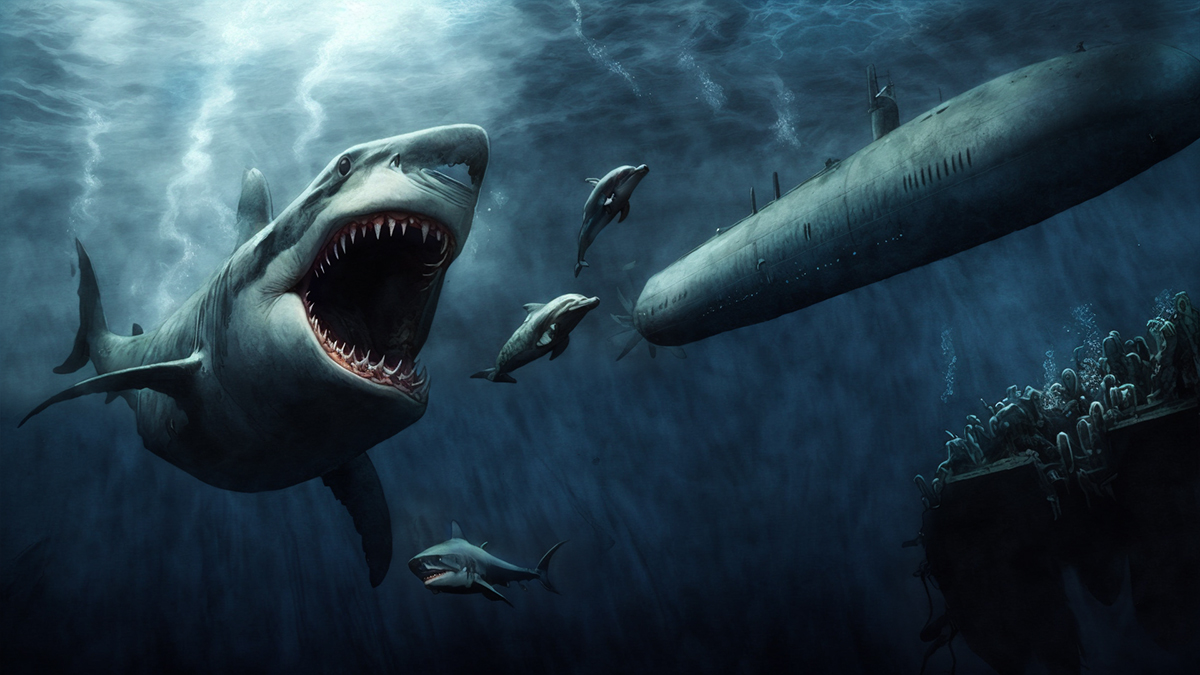The megalodon was a giant shark species that lived 2.6 to 23 million years ago, inhabiting the warm oceans of the world. However, there have also been purported sightings in more recent times.
Description
The megalodon is generally thought to have been between 12 and 21 meters long (40 to 70 feet), making it the biggest carnivorous fish that has ever graced the oceans. It weighed up to 60 tons. Compare this with the great white shark, which is between 4 and 6 meters long (12 to 24 feet) and weighs about 20 times less, and you begin to realize just what an incredible creature this shark was.
Ancient megalodon teeth have been discovered in locations and countries such as Africa, South America, Japan, and Australia, meaning the megalodon is very likely to have been a warm-water ocean dweller.
Scientists and researchers have agreed on some characteristics of the shark, but many elements remain up for debate. This is mostly due to the fact that sharks’ bodies are mostly cartilage. Cartilage breaks down very quickly – too quickly for the fossilization process. As a result, the only remnants on which scientists can base their research are teeth.
The scientific name of the creature, Otodus megalodon, actually means giant tooth, and the reason is pretty obvious.
Megalodon may have had up to 276 teeth positioned in five rows. As they lost their teeth so quickly, usually as a consequence of crunching bone and other teeth when eating their prey, these sharks always had new teeth ready to replace old or broken ones – a conveyor belt of teeth, if you will.
In addition to its many teeth, the megalodon shark had the most powerful bite of any animal on record. It is estimated that one of these sharks could bite a small whale in half and that its bite force was two or three times that of a Tyrannosaurus rex.
The megalodon is thought to have been a very aggressive shark. This shark probably fed on whales, sea cows, and sea lions, but the specifics of the megalodon’s diet are yet to be confirmed. Given this shark’s size, it probably had to consume around a ton of food every day in order to stay well-fed.
Also to be confirmed is why the megalodon became extinct. The main opinions are that, firstly, the temperature of the oceans began to get colder; therefore, the megalodon could not survive. Secondly, it is possible that the megalodon’s prey moved to colder waters, and these waters were too cold for the megalodon to live in.
In 2014, a Zurich-based research group determined that megalodon fossils date back to the middle Miocene epoch to the Pliocene epoch (15.9 million to 2.6 million years ago). The earliest homo sapiens emerged approximately 2.5 million years ago.
The group also claimed there is no evidence to suggest these creatures survived beyond 2.6 million years ago. But, the scientists also said there was a 1% chance that some of these sharks might have survived.
There are those who believe the megalodon is not, in fact, extinct. These people think it is possible that the megalodon is still living deep down in the oceans. However, as sharks shed their teeth at regular intervals and all of the megalodon teeth that have been discovered have been very old, it is virtually impossible that this enormous shark is still part of the food chain.
Sightings and Tales
In 1918, a crew of experienced Australian fishermen claimed their boat had been attacked by an enormous shark measuring between 35 and 90 meters in length. The men were so traumatized and terrified that they refused to return to work.
Whether or not a shark could reach that size is contentious, but these men were certainly credible. Could it have been a megalodon?
In the 1960s, the captain of a 55-foot fishing vessel said that a shark that was as long as his boat had passed by while the vessel was anchored. The captain, like the Australian fisherman, was very experienced and said it was certainly not a whale; he was convinced it was a shark.
In 2012, researchers spoke to some South African fishermen who believed there was a huge shark in the area. They believed the shark to be between 30 and 40 feet long.
In 2018, a giant-shark-like image was spotted on a camera at the bottom of the Mariana Trench, prompting hope that a megalodon was hiding in the great deep. This led cryptozoologist Dr Karl Shuker to comment on the huge number of regular sightings of ginormous creatures in the ocean.
However, expert Emma Bernard argued that the megalodon likely wouldn’t be able to survive in the cold waters of the trench. Bernard also argued that given the amount of food required by a megalodon each day, we would surely see other whales and sharks being attacked if megalodons still existed.
No official sightings exist, meaning there is no evidence to back up any of these stories. Could the megalodon be lurking deep down in our oceans, or is its existence too far-fetched?
| Other Name/s | Carcharadon Megalodon, Megatooth Shark |
| Location | Worldwide, |
| Type | Sea Monster, Extinct |
| Habitat | Ocean |
References
sharksider.com, “The Megalodon Shark,” accessed August 04, 2017.
fossilera.com, “10 Killer Megalodon Shark Facts,” accessed August 7, 2017.
exemplore.com, “Megalodon Sightings: Is the Megalodon Shark Still Alive?” accessed August 07, 2017.
sharkopedia.discovery.com, “Megalodon: The Prehistoric World’s Worst Nightmare,” accessed January 26, 2017,
https://www.livescience.com/63361-megalodon-facts.html, “Megalodon: Facts about the long-gone, giant shark,” accessed March 20, 2023,
https://www.mirror.co.uk/news/weird-news/terrifying-sighting-huge-shark-sparks-26921012, “Terrifying sighting of huge shark sparks debate about if megalodons still exist,” accessed March 20, 2023.
